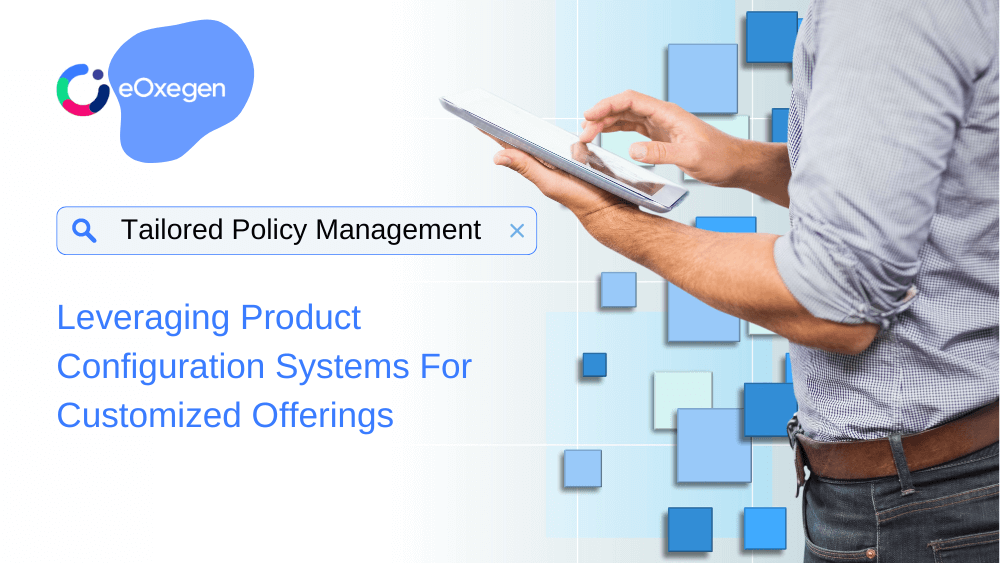Tailored Policy Management: Leveraging Product Configuration Systems for Customized Offerings
11 Feb, 2024

Picture the insurance world changing like a caterpillar into a butterfly. No more are the old ways of "one type fits all" insurance policies. Now, imagine an era where each insurance policy is put together like a puzzle, fitting perfectly for each policyholder's needs, like a tailored suit. This change is not just a dream; it's the new normal. Thanks to modern technologies, with the Insurance Product Configurator playing the lead role in this story of personalization.
In this ever-changing world, policyholders' requirements alter like the rise and fall of waves. Traditional ways of insurance are currently experiencing a deep change. The general use of default policies are decreasing, paving the way for a new period where custom-fit answers are key to the insurance process. Within this progression, there's the Insurance Product Configurator, a creative device that's molding the core of policy handling.
The Power of Personalization
Digital Transformation in Insurance
The digital revolution has not spared the insurance sector. As consumers increasingly seek convenience and tailored solutions, insurers are leveraging digital tools to streamline processes and enhance customer experiences. The Insurance Product Configurator is a prime example of this transformation.
Customizing Health Insurance
Health insurance needs are highly individualized, varying from one person to another. A health insurance product configurator allows users to select specific coverage options based on their unique health requirements. This not only ensures comprehensive coverage but also aligns with the growing trend of proactive health management.
Tailoring Life Insurance Policies
Life insurance is a deeply personal choice, often influenced by individual circumstances and financial goals. A life insurance product configurator empowers users to customize their policies, selecting the coverage, riders, and terms that align with their unique needs. This flexibility is particularly crucial as life situations evolve over time.
Advantages of Front-End-Driven Product Configuration
User-Friendly Experience
- The front-end-driven approach ensures that policyholders can easily navigate and tailor their insurance policies without requiring technical expertise.
- Intuitive interfaces guide users through the configuration process, enhancing the overall user experience and reducing the likelihood of errors.
Seamless Transactions
- Front-end-driven product configuration facilitates smooth and seamless transactions. Users can make real-time adjustments to their policies, instantly seeing how changes affect coverage and premiums
- This real-time interaction not only improves customer satisfaction but also provides transparency, fostering trust between insurers and policyholders.
Customization for Diverse Needs
- Insurance needs vary widely among individuals and businesses. Front-end-driven product configuration allows for a high degree of customization, enabling insurers to cater to a diverse range of requirements.
- This real-time interaction not only improves customer satisfaction but also provides transparency, fostering trust between insurers and policyholders.
Enhanced Speed and Efficiency
- By shifting the configuration process to the front end, insurers can significantly reduce the time and resources required for policy customization.
- Automated processes streamline the configuration workflow, allowing for quick response times and enabling insurers to adapt to market changes more rapidly.
Improved Communication
- Front-end-driven systems facilitate clear and transparent communication between insurers and policyholders. Users can instantly see the implications of their choices, making informed decisions about their coverage.
- This transparency builds a sense of trust and confidence, crucial for long-term customer relationships.
Implementing Product Configuration
Integration with Back-End Systems
While the front end steals the spotlight, seamless integration with back-end systems is crucial for a cohesive and efficient policy management process. This integration ensures that data entered through the front-end is accurately reflected in the backend systems, maintaining consistency and compliance.
Ongoing Training and Support
The power of these tools can only be harnessed if users and internal teams are well-versed in their functionality. Providing ongoing training resources and support is essential to maximize the benefits of these configurators. Regular updates to training materials should reflect any system enhancements or the introduction of new features.
Security Measures
With great power comes great responsibility. Implementing robust security measures is non-negotiable. Protecting user data and ensuring the integrity of the configuration process should be a top priority. Regular audits and updates to security protocols are essential to safeguard against potential threats.
Conclusion
As we navigate the era of tailored policy management, the role of Insurance Product Configurators, including digital insurance product configurator tools, cannot be overstated. Whether it's a health insurance product configurator catering to individual health needs or a life insurance product configurator aligning with unique life circumstances, these tools empower users and position insurers at the forefront of innovation. The front-end-driven advantage ensures not only a seamless user experience but also signifies a strategic move towards a customer-centric approach. As the demand for personalized insurance solutions continues to surge, those embracing these front-end-driven approaches are not just adopting technology; they are pioneering a new frontier in the insurance landscape.
Recent Articles
- How do Big Insurers Engage with the New-Age InsurTech Companies?
- Insurance Management System Integration: Maximizing Efficiency and Performance
- Will Blockchain Technology Reshape the Insurance Market?
- The Future of Health Insurance: Predictive Analytics and AI
- Buy or Build Insurance Software? A Game-Changing Question in Insurance Industry